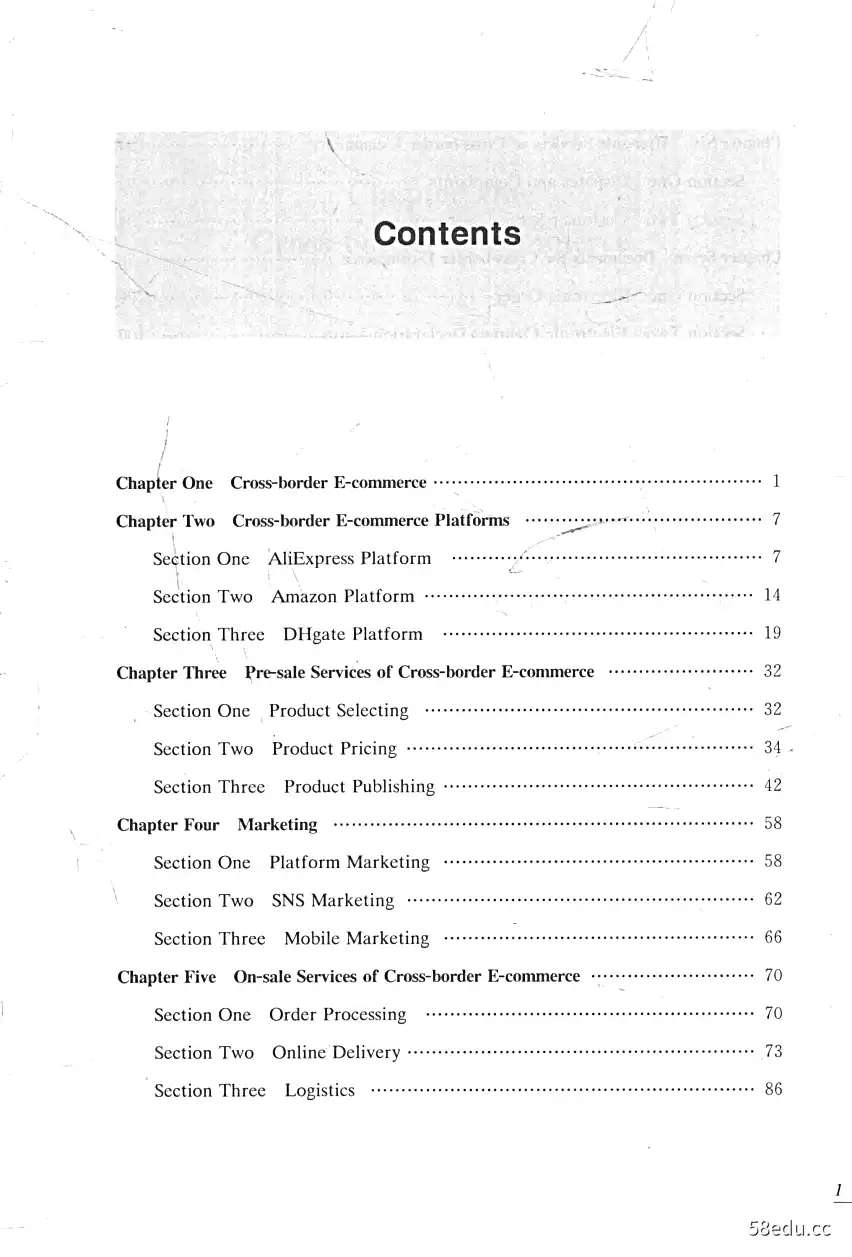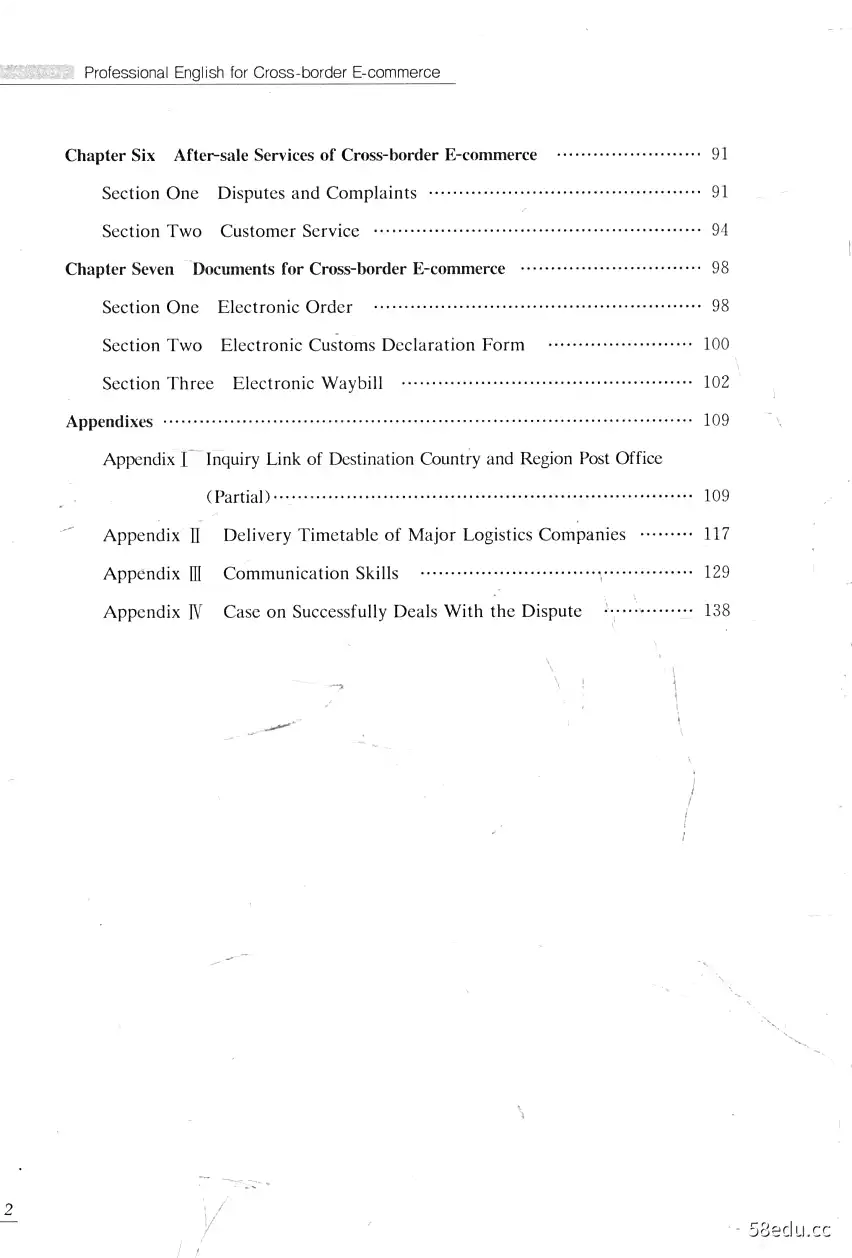《跨境电子商务专业英语》张式锋,孙圣涵主编|(epub+azw3+mobi+pdf)电子书下载
图书名称:《跨境电子商务专业英语》
- 【作 者】张式锋,孙圣涵主编
- 【丛书名】“十三五”高等院校跨境电商规划教材
- 【页 数】 140
- 【出版社】 上海:立信会计出版社 , 2018.01
- 【ISBN号】978-7-5429-5652-1
- 【价 格】26.00
- 【分 类】电子商务-英语-高等学校-教材
- 【参考文献】 张式锋,孙圣涵主编. 跨境电子商务专业英语. 上海:立信会计出版社, 2018.01.
图书封面:
图书目录:


《跨境电子商务专业英语》内容提要:
本书介绍了跨境电商业务各个环节,平台,售前,营销,售中,售后,支付,单证等环节所需专业英语。本书培养实操能力,突出实用性,可作为各类院校国际贸易、国际商务等相关专业的教材,也可以作为外贸跨境电商行业、国际商务从业人员培训用书。
《跨境电子商务专业英语》内容试读
Chapter One
Cross-border E-commerce
Introduction to Cross-border E-commerce
Cross-border E-commerce is becoming a hot topic in these years,and takingan important role in international trade field.The rise of Cross-border
E-commerce benefited from e-commerce.With the development of computertechnology and.e-commerce technology in 21st century,huge impacts ontraditional international trade are caused by the Cross-border E-commerce.
Nowadays,Cross-border E-commerce is leading a new development ofinternational trade.
In general,Cross-border E-commerce can be defined in both narrow andbroad sense.
In a narrow sense,Cross-border E-commerce is almost equal to cross-borderretailing,in which transaction parties in different countries reach agreements andsettle accounts through the Internet and deliver/receive the goods via cross-borderlogistics.
In a broad sense,Cross-border E-commerce is electronic foreign trade.It's akind of international business,in which the product display,negotiation andtransaction are done via the Internet and goods are delivered through cross-borderlogistics.
The Cross-border E-commerce mentioned in this book is the latter one.Itconsists of the cross-border online B2B,B2C deals as well as the B2B deals in O20pattern.
Professional English for Cross-border E-commerce
In terms of the export flow of Cross-border E-commerce Pic.1-1),producers or manufacturers display their products on a self-cross-bordere-commerce platform.After the products are selected and paid by customers,theywill be sent to logistics companies by cross-border e-commerce operators fordelivery.The products will finally reach the customers after two inspections atcustoms for export and import).Some Cross-border E-commerce operatorscooperate with third-party comprehensive platforms and entrust them withlogistic,goods inspection and like procedures.
Product
Cross-border
Payment
Logistics
E-commerce Company
Company
Company
Customs
Customer
●
Cross-border
E-commerce
Third-party Comprehensive
Consumer
Export
Producer/Manufacturer
Platform
Service Platform
心
Company
Self-run Cross-
border
E-commerce
Company
Consumer/
Cross-border
Import
Customs
Producer/
Company
Clearance
Logistics
Payment
E-commerce
Company
Manufacturer
Pic.1-1 Export flow of Cross-border E-commerce
The import flow is just opposite to export flow.
As a business model based on the Internet,Cross-border E-commerce isrebuilding the international trade chain of SMEs.By breaking the monopolyof foreign channels such as importers,wholesalers,distributors and retailers,which exists in traditional foreign trade,Cross-border E-commerce enablescompanies to contact with individual wholesalers,retailers and even consumersdirectly,which effectively simplifies the transaction and saves goodscirculation costs.Pic.1-2)
2
Chapter One Cross-border E-commerce
Traditional
Chinese
Chinese
Foreign
Foreigr
Foreign
Foreign TradeProducer/Manutacturer
Exporter
wholesaler
Cross-border
Chinese
Cross-border
Foreign Online
Foreign
-commeree
Producer/Manufacturer
Merchant
Chinese
Cross-border
Foreign
Producer/Manufacturer
Platform
Merchant
Cross-border
hine
Producer/Manufacturer
Platform
onsumer
Pic.1-2 Traditional Foreign Trade Cross-border E-commerce
Chinese Policies of Cross-border E-commerce
The making of policies about Cross-border E-commerce in China can besummed into three stages.(Pic.1-3)
◆Developmentpath ofcross-bordere-commerce
Boom Stage
Development Stage
Star of B2C import platforms
Development of B2C export platforms
Early Stage
Transformation of B2B export platfonns
Start of B2C export platforms
Growth of B2B platforms
Start of B2B platforms
1999
2008
2014
YEAR
Pic.1-3 Three stages of Cross-border E-commerce in China
Early stage (1997-2007),in which 3 polices preliminarily regulate thedevelopment of e-commerce,placing extra emphasis on the industry;
Development stage (2008-2013),in which 10 policies involve supervision,payment,settlement and so on,placing extra emphasis on support and guidance;
Boom stage (since 2014),in which more than 10 polices focus on export andinvolve implementation.
Different between customs and national boundaries
Customs is a geographical area within which goods may move freely without
3
Professional English for Cross-border E-commerce
being subjected to customs duties.It generally,but not necessarily,coincides withnational boundaries.When a customs area encompasses more than one distinctnational area,it is known as a customs union.The economic significance of acustoms area lies essentially in the movement of goods within the area withoutpayment of tariffs or duties,thus permitting greater efficiency in productionunder more favorable conditions of specialization and trade with a consequent riseof the standard of living within the area.
In this book,we mainly use customs rather than national boundaries,which isalmost the same in international trade.
Customs Supervisions
Regarding the goods traded via Cross-border E-commerce,there are mainlythree means for goods to cross customs.
Customs clearance of goods.For the situation that Chinese'import and exportcompanies display products and make agreements with foreign wholesalers andretailers online and finish shipment offline,these.goods shall be included incustoms statistics.
Customs clearance of express.According to a survey carried out by.General
Administration of Customs,more,than 95%of the goods traded via Cross-border
E-commerce and delivered by the five biggest express companies in China aredeclared as import and export goods at customs and are included in cargo statistics.
Only less than 5%of the goods are declared as personal belongings and are notincluded in customs statistics.
Customs clearance of mail.Goods bought online and delivered by mail aremainly daily essentials.According to related regulations issued by General
Administration of Customs and the State Council,goods for personal use ofreasonable amount are out of compulsory customs clearance and statistics.
Different Customs Clearance
For different trading modes of Cross-border E-commerce,there are fourdifferences in custom clearance.
B2B export.If goods are exported on a large scale,they are actually intraditional trade.For goods exported on a small scale by express or mail,it's hardto get customs forms,and there are also some troubles in goods inspection,settlement of exchange and tax rebate.
Chapter One Cross-border E-commerce
B2B import.The overall situation is basically the same as that of B2B export.
B2C export.For it mainly targets overseas customers with relativelysmall orders but high trading frequency,and goods are usually delivered byexpress or mail,it is not included in current customs regulatory system,sothere are also some troubles in goods inspection,settlement of exchange anddrawback.
B2C import.The goods are mainly bought for individual use and delivered byexpress or mail,which is not,involved in customs statistics.
Exploration of Customs Clearance of Express and Mail
While doing Cross-border E-commerce,goods delivered by express and mailoften face troubles in customs clearance,settlement of exchange and tax rebate.
In order to solve these problems,General Administration of Customs selectedsome pilot cities to study the standard regulations and management system of
Cross-border E-commerce and improvement of customs clearance management andservice.
In December 2012,General Administration of Customs officially selected fivecities including Shanghai and Chongqing as the pilot cities.In October 2013,theproject was carried out in some other suitable cities which are usually logisticscenters,port cities,places of origin,etc.
There are four kinds of business can be applied for by pilot cities.Accordingto General Administration of Customs,only six cities,including Chongqing,
Guangzhou and Shanghai,are allowed to operate import business of Cross-border
E-commerce,and other cities can only deal with export business.
Cross-border E-commerce in China
From 2010 to 2013,China Cross-border E-commerce business has beeninitially developed.Companies likes Yangmatou,Xiaohongshu,that mainly focuson C2C purchasing mode have been established.From 2014 to early 2015,is thepolicy dividend period,a large number of cross-border electricity businessplatforms set up,giant internet companies such as AliExpress,Amazon,NetEase,etc.also entered the market.Since 2016,Cross-border E-commerce market has
Professional English for Cross-border E-commerce
developed rapidly,with the high-intensity competition.
According to statistics,in 2015,the transaction amount of China Cross-border E-commerce business reached 4.8 trillion yuan,rising by 28%and makingup 19.5%of the total foreign trade volume.China Cross-border E-commercebusiness is currently export-oriented,export transactions account making up
83.1%of total business transactions,while imports only accounted for 16.9%.
According to the business model,China Cross-border E-commerce business iscurrently B2B-based,which contributed for 84.3%of total Cross-border
E-commerce trade volume in 2015,left 15.7%space for the retail sales.
However,the retail sales are increasing rapidly.In 2015,China Cross-border E-commerce retail sales amounted to 751.2 billion yuan,got about 69%increasethan last year.
Exercises
Translate the following words into Chinese.
1.Cross-border E-commerce
2.B2B
3.B2C
4.Customs clearance
5.General Administration of Customs
6.Settlement of exchange
7.Parallel trader
6
···试读结束···
作者:戚小明
链接:https://www.58edu.cc/article/1714531954893864962.html
文章版权归作者所有,58edu信息发布平台,仅提供信息存储空间服务,接受投稿是出于传递更多信息、供广大网友交流学习之目的。如有侵权。联系站长删除。